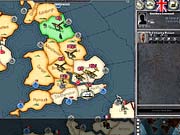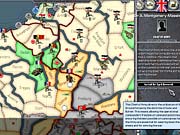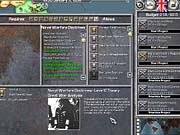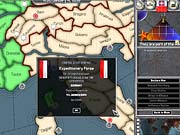Hearts of Iron Preview
Hearts of Iron will be the successor to Europa Universalis. Get the details in our preview.
Hearts of Iron is in many ways the successor to the Europa Universalis series. It's a massive-scale real-time strategy game that's laced with historical fact. The game is being developed by the Europa Universalis team and uses the same basic graphics engine. But while Hearts of Iron will feature the grand scale and exhaustive detail that the Europa Universalis series is known for, it will shift the focus to the World War II era and will make a number of improvements to the gameplay of its predecessors.

In Hearts of Iron, you control a country between the years of 1936 and 1948. You are responsible for almost all matters of state, from appointing governmental leaders to overseeing your nation's production, research, and military. Hearts of Iron initially seems like it consists mainly of a multitude of disparate menus, but once you grasp all the individual factors that play a part in your nation's well-being, it should all come together.
The interface in Hearts of Iron is virtually identical to that of Europa Universalis. The battle map, which now encompasses the entire world, commands the center of the screen. To the right are the various tabs for production, technology, diplomacy, and government. You will directly control your country using these various menus and screens. The main gameplay components of Hearts of Iron all revolve around these five menus. The production screen allows you to manage your nation's industries, deploy the convoys that ship the game's raw materials, and trade on the ever-changing world market for goods. The technology screen allows you to manage your research. The military screen lets you create new army divisions and adjust their production rate. The diplomacy screen allows you to interact with other countries, and the governmental screen lets you set up the hierarchy of your government.
One change being made for Hearts of Iron is the addition of ministers who oversee certain parts of your government. You appoint ministers using the governmental screen, and each candidate is presented with a historically accurate biography and a quick description of his leadership style. For example, if you were playing as Germany, one of the candidates for armaments minister would be Hermann Göring, and a quick check of the description of his leadership style would reveal that he is an "air-to-ground proponent." By carefully choosing which ministers you appoint to key positions, you can keep very accurate control over the direction and methods of your government.

Also seeing a major overhaul since the Europa Universalis days is the diplomacy screen. Representing the ideological struggle behind World War II, a new triangle depicts national political orientation. The three tips of the triangle represent fascism, communism, and democracy, and each nation can lie anywhere in between the three extremes on the triangle. Three major alliances spawn from the major ideological branches: the Allies, the Axis, and the Comiturn. England leads the Allies, Germany leads the Axis, and the Soviet Union leads the Comiturn. The Comiturn can join sides with either the Axis or the Allies.
In order to carry out diplomatic actions in Hearts of Iron, you need diplomatic influence points. You'll be able to demand territory, stage a coup, influence a nation toward your worldview, and more. The closer the nations are in alignment to you, the more likely they'll be to join you in an alliance. Any nations allied with you will automatically join you in war. The effects of diplomatic actions are usually immediate, and you'll be able to see the ramifications of your actions immediately. Other diplomatic actions include sharing research, assuming control of an ally's military, requesting an ally to execute a specific attack, and more.
Putting the "War" in "World War"
Maintaining a good supply of resources is crucial to success, as you need to keep your country well supplied in order to properly support your industries. And your industries are very important, as they allow you to produce consumer goods to make people happier and supplies to keep your military stocked, discover new technology, and increase your nation's production. You must also establish a balance in the amount of resources you devote to your different industries, as emphasizing some areas will mean that you'll have to cut back in others.

Maintaining a good supply of resources can be accomplished in many different ways. One is to set up convoys. Convoys transport goods from one province to another, and you can set what is transported, how many vehicles or ships will be involved, and how many escorts will accompany the convoy. Obviously, convoys are also important targets during wars, as they act as a nation's supply chain.
The technology tree has also received a major overhaul for Hearts of Iron. The technology screen is now chock-full of real WWII technology, and the tech tree includes dozens of different categories of projects, each with dozens of possibilities. Each category has many different levels of development. Clicking on one project shows what it allows and what it requires. By clicking on what the project allows, and then what the next project allows, and then what the next allows, and so on, you can effectively plan out your research.
Of course, what would World War II be without the war? Hearts of Iron's military system is fairly complex, and it supports the formation of large units from multiple divisions of troops for added strength. In terms of constructing units, there are many different possibilities for land, sea, and air. The options for land units include mechanized infantry, various types of tanks, cavalry, and more. There are plenty of ships available for building as well, including battleships, cruisers, destroyers, aircraft carriers, submarines, and transports. Aircraft include fighters, tactical bombers, and dive-bombers. The abilities of the units are all affected by the level of completed research, and their use relies upon allocating a sufficient production to supply your units with ammunition and repairs.

The combat in Hearts of Iron is very tactical and very precise. When attacking, you can specify the day, the time of day, and the attack mode. For land units like tanks, you might find three different attack modes, like feint, blitz, and regular attack. Each attack is used for different purposes, and other attacks are available for other units. Being able to coordinate an attack according to a specific timetable--starting with aircraft bombing runs, following with a panzer rush, and then finishing with an infantry charge, for example--is very true to life, and being able to plan in such detail is a rarity in real-time strategy games.
Hearts of Iron's music is also noteworthy, as it is a collection of famous period classical music. Including well-known tunes like "Flight of the Valkyries," the music is very fitting, and it resonates well with the deep historical content of the game.
Though Hearts of Iron may seem very statistical and abstract, with many menus and layers of information, it also seems extraordinarily deep. Because of that, Hearts of Iron probably won't be the easiest game to pick up, but the game's meticulous attention to historical detail is astounding. Hearts of Iron is due out in early November.
Got a news tip or want to contact us directly? Email news@gamespot.com
Join the conversation